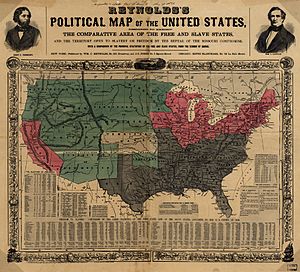Bleeding Kansas facts for kids
Quick facts for kids Bleeding Kansas |
|||||||
|---|---|---|---|---|---|---|---|
| Part of the prelude to the American Civil War | |||||||
 1856 map showing slave states (gray), free states (pink), and territories (green) in the United States, with the Kansas Territory in center (white) |
|||||||
|
|||||||
| Belligerents | |||||||
| Anti-slavery settlers (Free-Staters) |
Pro-slavery settlers (Border Ruffians) | ||||||
| Casualties and losses | |||||||
| Disputed - 100+ | 80 or fewer; 20–30 killed | ||||||
Bleeding Kansas was a series of violent events in the Kansas Territory and western Missouri. It happened between 1854 and 1861. This conflict was a major step toward the American Civil War.
The fighting was between groups with very strong beliefs about slavery. Some people wanted Kansas to allow slavery, while others wanted it to be a free state. The term "Bleeding Kansas" was first used by Horace Greeley of the New York Tribune. He used it to describe the terrible violence happening there.
Three main groups were fighting for control in Kansas. These were people who supported slavery (called pro-slavery), those who wanted to end slavery completely (called abolitionists), and those who wanted Kansas to be a free state (called free-staters).
Bleeding Kansas showed that a big conflict over slavery was coming. It was like a small war that happened before the much larger American Civil War.
Contents
Why Kansas Was "Bleeding"
The main question was whether Kansas would become a slave state or a free state when it joined the United States. This was a huge deal for the whole country. If Kansas became a slave state, it would change the balance of power in the U.S. Senate. The Senate was already deeply divided over slavery.
The Kansas-Nebraska Act
In 1854, the Kansas–Nebraska Act was passed. This law said that the people living in Kansas would decide for themselves if slavery would be allowed. This idea was called popular sovereignty. It meant the decision would be made by a vote of the settlers, not by politicians in Washington.
Two Sides, Strong Beliefs
People who supported slavery believed they should be able to bring their enslaved people, who they considered property, into Kansas. On the other side, many people were against slavery. Some thought it was wrong for religious or moral reasons. Others worried that rich slave owners would take over all the good land. This would leave no room for poorer settlers who didn't own slaves.
Missouri, a slave state, was right next to Kansas. Many pro-slavery settlers from Missouri, called Border Ruffians, crossed into Kansas. They tried to influence the votes and claim land there.
Violence and Chaos
The conflict wasn't just about politics. It turned into brutal gang violence and a type of fighting called guerrilla warfare. This is where small groups use surprise attacks.
Kansas ended up with two different governments and two different constitutions. One was anti-slavery, and the other was pro-slavery. Both sides believed they represented what the people of Kansas wanted.
The pro-slavery groups often used violence and threats. In response, anti-slavery settlers, led by people like John Brown, felt they had to fight back. Even though most Kansans wanted Kansas to be a free state, Southern politicians in Congress blocked this for a long time.
Kansas Becomes a Free State
Finally, Kansas was allowed to join the Union as a free state on January 29, 1861. This happened because many Southern senators left Congress during the time leading up to the Civil War. Their departure allowed the bill to pass.
Even after Kansas became a state, violence continued along the Kansas-Missouri border during the Civil War. Bleeding Kansas showed everyone that the disagreements over slavery would likely lead to a much bigger war.
Historic Site
In 2006, a special area was created called the Freedom's Frontier National Heritage Area (FFNHA). One of its goals is to teach people about the stories of Bleeding Kansas. This heritage area includes 41 counties, mostly in eastern Kansas and western Missouri. It helps us remember the long fight for freedom.
Related pages
- Kansas
- Kansas in the American Civil War
- Pro-slavery (United States)
- Free-Stater (Kansas)
- Abolitionism
Images for kids
-
1855 Free-State poster
-
Preston Brooks attacking Charles Sumner in the U.S. Senate in 1856
-
Tragic Prelude, a famous painting in the Kansas State Capitol
See also
 In Spanish: Bleeding Kansas para niños
In Spanish: Bleeding Kansas para niños




